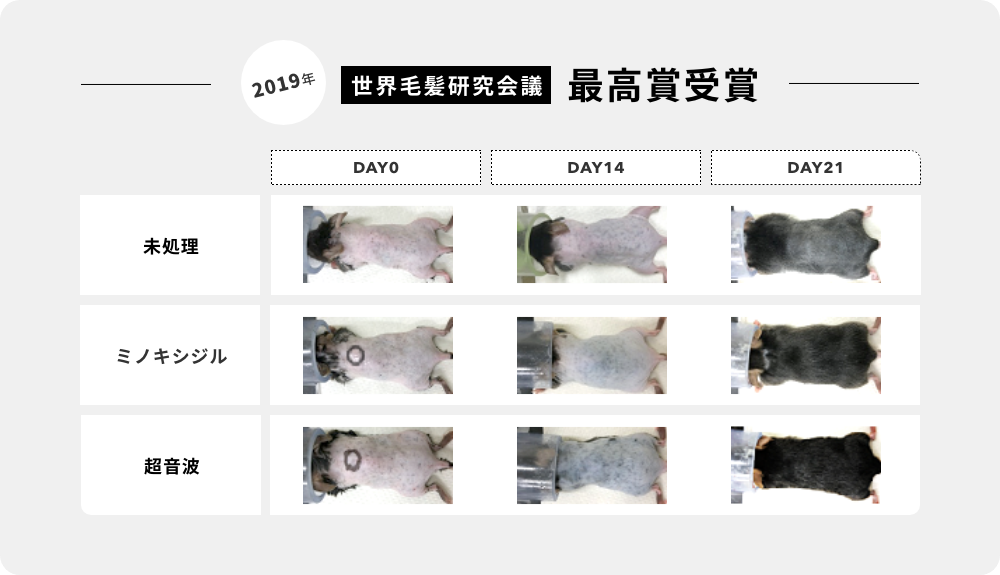
This technology promotes hair growth through non-contact vibrotactile stimulation using airborne ultrasound and is expected to be applied to new hair care and AGA treatment. It can also be used in combination with other hair care methods such as hair regrowth agents (minoxidil).
The population of Japanese males suffering from thinning hair (including AGA) is reported to be 12.6 million 6.5 million of whom have had some kind of care or treatment. Topical minoxidil, one of these treatments, has the issues that about 4 to 6 months are required until the effect can be felt and that the effectiveness is limited to a certain degree in a state where AGA has progressed to a later stage.
Pixie Dust Technologies has been working on applying its proprietary wave control technology to promote wound healing by non-contact vibrotactile stimulation using ultrasound. This is a joint research project with Nippon Medical School and has been funded by AMED-CREST since 2017. In this effort, it has been discovered that hair growth is also promoted in mice during the experiments for wound healing. The business feasibility of this project was examined with D Clinic, which specializes in hair treatment, and a clinical study conducted from 2019 to 2020 on healthy males aged between 20 and 30 confirmed that non-contact vibrotactile stimulation increased the percentage of anagen hair and decreased the percentage of telogen hair.

We have irradiated the non-contact vibrotactile stimulation to the scalp for twenty minutes once a week and have observed the change in anagen hair and telogen hair after 16 weeks or so. As a result, the irradiated group showed a 32.1% decrease in the percentage of telogen hair and an 10.2% increase in the percentage of anagen hair. According to the investigator, none of the subjects had any adverse events that could be attributed to non-contact vibrotactile stimulation.
<Case>
■Case.1
Device for beauty salon/clinic. An ultrasonic device is fixed to an arm or pole, and it can irradiate ultrasonic waves to the head from a distance.
■Case.2
Device for home use. Sufficient ultrasonic can be output and can be used for daily hair care with handheld size and weight.
■Acoustic radiation pressure
Non-contact vibrotactile stimulation technology uses airborne ultrasonic waves to stimulate the skin without contact. The ultrasonic waves emitted by a number of ultrasonic speakers are properly controlled to form a focal point. When the strong ultrasonic waves at this focal point are reflected off the skin, they exert a pushing force on the skin. This phenomenon is unique to strong ultrasonic waves and is called acoustic radiation pressure. The non-contact stimulation has the advantage of eliminating the risk of contact infection when used in medical applications, and the device is less likely to get dirty.
■Mechanobiology/Mechanotherapy
Mechanobiology is the research field of the body's response to mechanical stimuli. Mechanotherapy is the clinical application of mechanobiology research results, leading to new medical technologies. Recent research has shown that even weak stimulation by acoustic radiation pressure is effective in promoting wound healing and hair growth. We are currently conducting research on the mechanism in collaboration with Nippon Medical School.
■Main Achievements
[Conference] T. Hama, H. Takada, Y. Osada, T. Koyama, K. Kobayashi, T. Hoshi, and R. Ogawa: Examination of hair changes caused by irradiation with a non-contact focused ultrasonic device, 26th Annual Meeting of Japan of Clinical Hair Restoration, Online, November 6-7, 2021.
[Conference] H. Takada, Y. Nagata, T. Hama, A. Sakai, T. Hoshi, T. Koyama, K. Kobayashi, H. Suzuki, and R. Ogawa: Non-contact focused ultrasound activates KATP channels and promotes hair growth, Abstract of 28th Hair Science Conference, Shiba-Koen, December 5, 2020.
[Conference] H. Takada, Y. Nagata, A. Sakai, T. Hoshi, H. Suzuki, R. Ogawa: Novel hair growth effect by cyclic pressure stimulation, Abstract of the 29th Annual Meeting of the Japanese Society of Plastic Surgery, O-11-6, Minatomirai, October 8-9, 2020.
[Conference] H. Takada, Y. Osada, T. Hama, T. Koyama, K. Kobayashi, and R. Ogawa: Does hair follicular KATP channel gating by minoxidil- and/or mechano-stimulation contributes to hair growth in vivo?, 11th World Congress Hair Research, 24-27 Apr. 2019.[The Best Oral Presentation Award].
[Conference] H. Takada, M. Ueda, H. Sano, T. Koyama, R. Ogawa, T. Hoshi, K. Furuya, K. Kijima, Y. Nagata, T. Hama, K.: Cyclic pressure stimulation of hair papilla cells and the action mechanism of minoxidil, The 85th Annual Meeting of the Japan Medical Association, P-3, Mukogaoka, September 2, 2017.